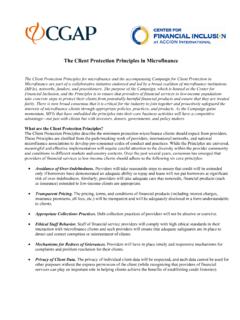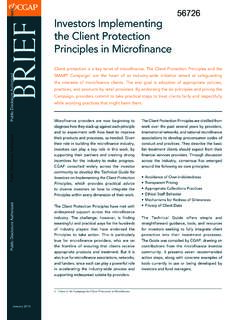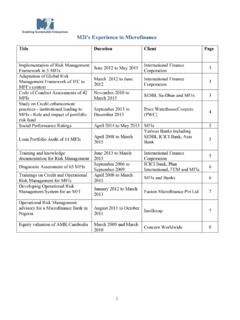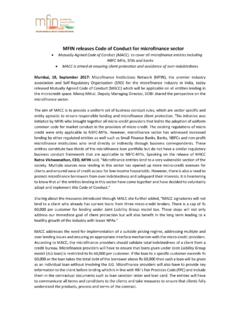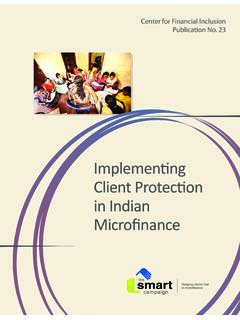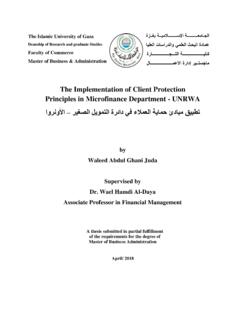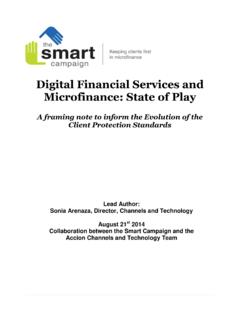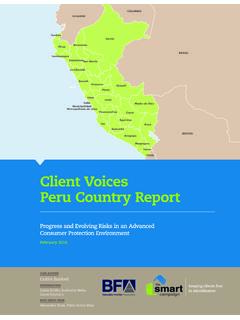Transcription of Client Protection in Microfinance 2 1 - e-MFP
1 About color themes Choose the appropriate design theme for your presentation. The first two options on the design tab are correct EY themes, these two are the only ones that should be used. (1) light backgrounds for handouts; (2) dark backgrounds onscreen. 1 ! 2 Client Protection in Microfinance The current state of law and regulation Luxembourg, 14 November 2014 Agenda The research Results Conclusions Discussion The research Context: Growing sector Global financial crisis Over-indebtedness of Microfinance clients Development of specific Microfinance law and regulation Scope: We studied the regulatory and supervisory landscape of the twelve countries in terms of Client Protection , focusing in particular on the following aspects.
2 Over-indebtedness; Responsible pricing; and Transparency Context and scope The research Regulatory framework: Which rules (laws or otherwise) are implemented in your country to protect Microfinance clients ? How are these rules/laws different for Microfinance institutions and regular bank and non-bank financial institutions? Which parties are involved in setting rules/laws concerning Client Protection in your country & how? What rules (laws or otherwise) have been implemented regarding over-indebtedness towards the Client ?
3 What rules (laws or otherwise) have been implemented regarding responsible pricing towards the Client ? What rules (laws or otherwise) have been implemented regarding transparency towards the Client ? What formal code of conduct is available on the basis of which financial service providers commit to mutually agreed standards within the Microfinance sector? Oversight and enforcement: What oversight and supervisory bodies check compliance with rules set? How is compliance checked & enforced by these bodies/institutions?
4 What type of credit reporting system is in place in your country? Trends and concerns: What are the major concerns and issues on the three focus Client Protection principles in Microfinance in your country? What are the major trends/developments in the area of Client Protection in Microfinance in your country? Questionnaire The research Geographical scope Specific Microfinance regulation: With the growth of the Microfinance industry, countries have started to develop and implement law and regulation specifically for this sector.
5 Seven out of twelve countries in scope have specific Microfinance law and regulation: Bolivia Cambodia Ghana India Kenya Russia Uganda Provisions on Client Protection are not always included in law and regulation aimed at the Microfinance sector. Regulation is also used as a tool to facilitate and encourage the growth of the sector (for instance in Bolivia). Regulatory bodies: The local central banks play a central role in developing law and regulation for the Microfinance sector.
6 In some countries, other regulatory bodies are also involved, such as insurance regulators. Microfinance associations are active in developing regulation and are mostly involved in a consultative capacity. Consumer Protection agencies are mostly not involved in the regulatory process. They are more active in conflict resolution and education of Microfinance clients . Regulatatory landscape Results Over-indebtedness Results Law and regulation regarding over-indebtedness for the regular financial sector does not apply to most Microfinance institutions.
7 Five out of twelve countries in scope have law and regulation that is specifically aimed at Protection Microfinance clients against over-indebtedness. This law and regulation focus on the appraisal of the character, payment history and payment capacity of each Client . SMART-campaign on over-indebtedness: many within the sector have seen an overemphasis on the supply side, which can have the effect of Microfinance institutions not adequately knowing their clients repayment capacities Responsible pricing Results Five out of twelve countries in scope have specific law and regulation regarding responsible pricing.
8 In the other countries, price setting is left to the market. Here, law and regulation focus more on the sales process and transparency. While most countries focus on the process of setting prices, India and Russia have set limits on the interest rates and processing costs. SMART-campaign on responsible pricing: [p]ricing, terms and conditions will be set in a way that is affordable to clients while allowing for financial institutions to be sustainable. Providers will strive to provide positive real returns on deposits Transperancy Results With nine out of twelve countries that have law and regulation on transperancy, this subject is relatively well-covered.
9 The focus of these provisions is on providing a fair and clear picture of the costs involved, and terms and conditions. In addition to law and regulation, educating Microfinance clients is another priority in many countries. Microfinance associations and consumer Protection agencies are active in this area. SMART-campaign on transperancy: Providers will communicate clear, sufficient and timely information in a manner and language clients can understand so that clients can make informed decisions.
10 The need for transparent information on pricing, terms and conditions of products is highlighted Enforcement Results Central banks and other regulators are the most important enforcement organisations in the Microfinance sector. External auditors, Microfinance associations and special Microfinance authorities also carry out enforcement and monitoring activities. Enforcement of Client Protection law and regulation is still developing. Some Microfinance institutions are not audited. When they are, the focus of enforcement and oversight is often on financial requirements.

